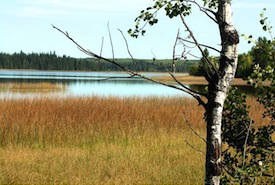Wild wetland wonders

Wetland at the Parklands Area, SK (Photo by NCC)
At the Nature Conservancy of Canada's (NCC's) Saskatchewan Region, we get excited about our wetlands and the value they contribute to society, to nature and to wildlife.
Defining a wetland
Often known as sloughs, potholes or wetlands are any area of land covered by shallow water with grasses and sedge, or any exposed large, flat basin holding little or no water during dry years. Most of these indentations were formed about 10 thousand years ago at the end of the last Ice Age. Huge chunks of glacial ice left behind in the soil melted and filled the holes with water. Today, snow and rain account for about 30 to 50 percent of the water in wetlands, with rainfall and groundwater seepage making up the rest.
A muskeg, a marsh, or...?
Wetlands are usually classified by the type of vegetation or plants they support. The density, abundance and types of plants around the outer edge or shoreline of the wetland helps determine how each specific wetland functions.
Mineral-rich fens and the more acidic bogs (also known as muskegs) support moss, low shrubs and coniferous trees. These lowlands also gather peat deposits at or above the water table and are more prevalent in more northerly areas of Saskatchewan.
On the southern plains, the fresh water or slightly saline wetlands, which sometimes vary considerably in size, are categorized as marshes because they support grasses, herbs, bulrushes, cattails and other pondweeds.
Some wetlands are only apparent in spring. Others hang on until mid-summer and others sustain year-round. They may be very tiny or even salty and others, vast, but they're all considered wetlands — and worth keeping.
Working wonders
Wetlands are a vital component of our groundwater systems. They act like storage and supply tanks, transfer basins or discharge ponds, depending on how water moves through them.
Inflow basins and small seasonal wetlands store water that is slowly released down into the ground to recharge the water table. These temporary wetlands may appear in any low place and many times in the indents of hilly upland areas.
Through-flow basins may be found on sloping terrain where water flows in from one side and out the other. Most common are the groundwater discharge basins where water flows out from the aquifer to the surface, something like a natural spring. Along the way the groundwater may pick up salts from the soil. If poor drainage exists, salts may deposit on the soil's surface.
Overall value
Wetlands are constantly changing, and this process of change helps make them productive. When these areas overflow in spring, organic material and other nutrients are carried out in the water and help restore soil quality. Intermittent dry periods in wetlands promote decomposition of organic matter, so even when dry, wetlands are working.
Regardless of their primary purpose, these areas are of enormous value on our landscape. They support wildlife, filter ground and surface water, are great for recreation and relaxation and they're even the subject of considerable education about wildlife! They are part of our heritage as well, as many communities were established near these water sources, helping provide food, recreation and transportation for our early settlers.
Wetlands also provide the intangible! As our human world grows more hectic and demanding, wetlands remain special places where nature and people harmonize.
How NCC manages wetlands
Field staff periodically visit the properties that NCC owns and those on which NCC holds a conservation agreement with the landowner. Many times these visits help staff monitor the lands to ensure livestock that access wetlands are not damaging the vegetation or severely disrupting the ground around these wet areas.
Sometimes it is necessary to restrict cattle from grazing these areas, at least until they dry, to avoid hooves punching deep into muddy edges, destroying plant growth and perhaps compromising the effectiveness of the wetland. Placing cattle watering systems away from wetland areas is an effective stewardship technique that helps reduce the impact of livestock in and around wetlands.
NCC's Saskatchewan Region also works with partners such as Ducks Unlimited Canada in efforts to enhance or restore wetland areas and the wildlife habitat they support. For instance, on NCC's Horseshoe Lake 2 property in east-central Saskatchewan (near Good Spirit Lake), efforts are underway to restore a previously drained wetland to its original 10-acre (four-hectare) area. This effort helps reduce erosion and flooding from the flow of water over ground, and the fish and wildlife that rely on this habitat will have more opportunity or choice for great wetland homes.





